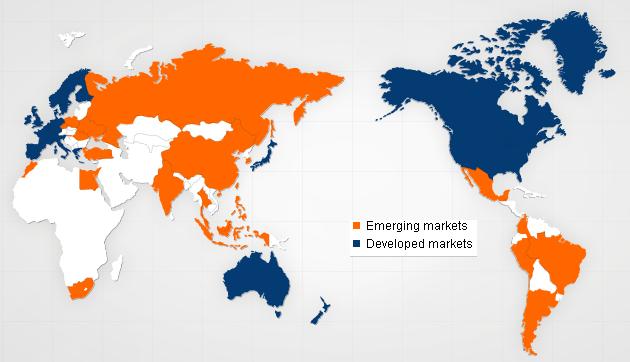Of late emerging markets have become a buzzword among the international investors for reaping greatest potential rewards which would be impossible if they stayed put in their affluent hinterlands. The term emerging markets (EMs) is a collective reference to the stock markets of the developing nations. A question, which overpowers a discerning mind, is why the international investors are looking towards emerging markets for investing their funds instead of established markets like US? Three reasons can be given to answer this question.
First, the average total return of emerging markets has outstripped those of developed markets. Investments total return index computed by the IFC (International Finance Corporation) which measures the total return for each country based on those stock available to foreign investors shows that return on investment in IFC composite of EMs is 61.64 per cent higher than the return on investment in US market over the years. The institutional investors like the corporate pension funds; insurance companies and international mutual funds are looking towards investments in EMs to magnify their earnings.
Secondly the emerging markets provide excellent scope for diversification, as their correlation with the US and other developed markets is often exceptionally low. The EMs has low correlations not only with the developed markets, but also with each other. The fact that EMs (individually and as a group) has low correlations with the developed markets implies that there is an opportunity for diversification for the global investor.
Thirdly as the emerging markets are generally inefficient markets, the opportunity of finding bargain stocks increase for the highly knowledgeable money managers. It is comparatively easier to beat the markets in the EMs as compared to developed markets. In developed markets more arcane ones with mixed results have supplemented the traditional tools of Fundamental Analysis and Technical Analysis. For example, there are computer programmes called Neural Networks, which seek to identify underlying general patterns in share price movements to obtain clues about future prices. The evidence so for is inconclusive. The problem may be that such tools are quickly adopted by a large number of players so that they soon become history. In such a situation the investors are attracted by what they consider to be the relatively inefficient markets of developing countries. Perhaps their tools of analysis will yield good results there.
Fall in the real interest rates in US coupled with a strong growth in the developing world spurred on the demand for emerging market equities which pushed market beyond their fundamental values.
Considered on the risk from EMs are extremely risky when compared with developed markets. Apart from the obvious threats (political instability, insider trading and others), there are a number of possible reasons why these markets are extremely volatile. First they tend to be fairly concentrated; the larger stocks have a high proportion of the overall capitalization. As a result, there are fewer opportunities for diversification, and returns of these stocks dominate overall market return. Second, unlike the developed markets, which tend to have forces that affect diverse sectors of the economy differently, the EMs tend to have a strong market related force that affects all stocks within a market. This widespread effect tends to accelerate volatility. It is true that emerging markets are extremely risky taken individually, but considered together EMs provide a good scope for diversification as these markets have low correlations not only with each other, but also with the developed markets. It is a generally accepted fact that investment in unrelated markets reduces the degree of risk.
Credit: International Finance-CU
